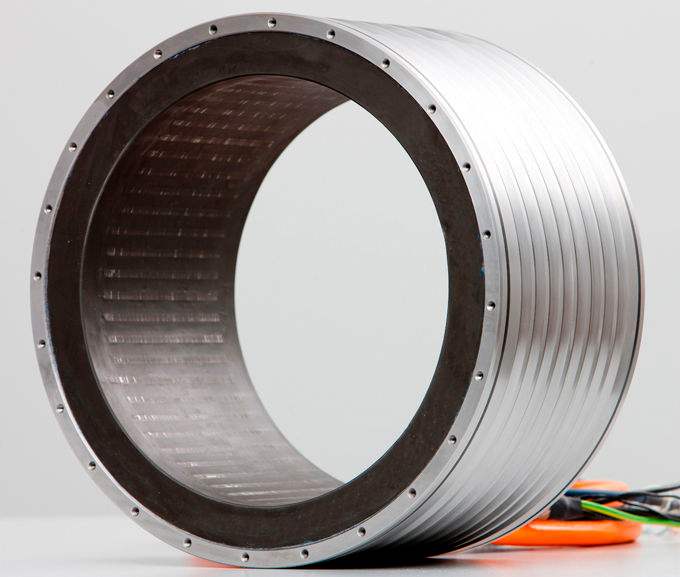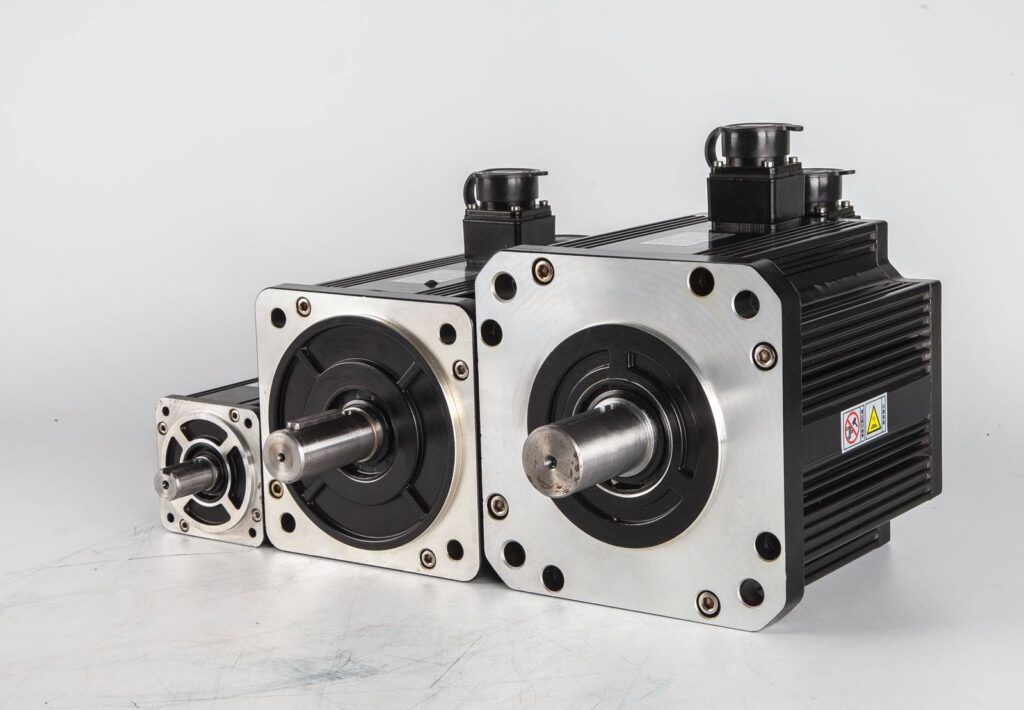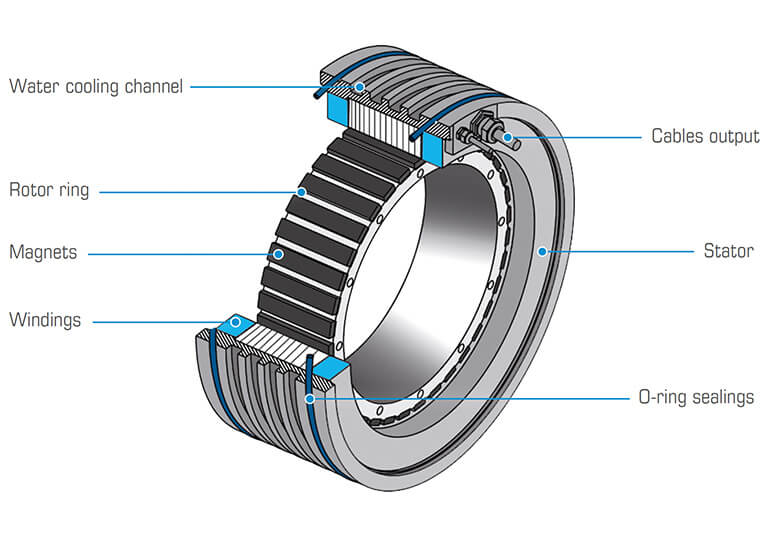The torque motor is a special motor with a large number of poles, which can continue to run when the motor is at low speed or even stalled (that is, the rotor cannot rotate), without causing damage to the motor. In this working mode, the motor can provide stable torque to the load. Torque motors can also provide torque in the opposite direction of rotation (braking torque). The shaft of the torque motor does not output power with constant power but with constant torque.

1. Brief Introduction
Torque motors include DC torque motors, AC torque motors, and brushless DC torque motors. It is widely used in machinery manufacturing, textile, paper, rubber, plastic, metal wire, and wire and cable industries.
2. Classification
01. DC torque motor

A special form of DC servo motor. Most of them use permanent magnet excitation. Its basic requirements are similar to DC servo motors. In order to obtain large output torque and low speed, it is generally made into a flat structure.
The working principle of the DC torque motor is the same as that of the ordinary DC servo motor, but the structure and the ratio of the external dimensions are different. In order to reduce the moment of inertia of general DC servo motors, most of them are made into elongated cylindrical shapes.
In order to generate relatively large torque and low speed under the same volume and armature voltage, the DC torque motor is generally made into a disc shape, and the ratio of armature length to diameter is generally about 0.2; from the perspective of structural rationality Considering that it is generally made into a permanent magnet multi-pole. In order to reduce the fluctuation of torque and speed, more slots, commutation pieces, and series conductors are selected.
There are two types of overall structure: split type and built-in type. The split-type structure includes three major parts: stator, rotor, and brush holder. The casing and rotating shaft are selected by the user according to the installation method; The shell and shaft have been assembled by the manufacturer.
02. AC torque motor

Its basic requirements are the same as those of AC servo motors. A wide speed range and softer mechanical characteristics are obtained by increasing the rotor resistance. Compared with the general asynchronous motor of the same frame size, the output power of the AC torque motor is several times smaller, the stall torque is larger, and the stall current is much smaller.
The AC torque motor generally adopts a cage rotor structure and obtains a low speed by increasing the number of pole pairs. It mainly operates in a state of heavy load and low speed, and can also be operated in a stalled state for a short or long time.
The speed control of the AC torque motor is realized by two methods: the speed feedback of the tachometer motor and the control of the tension.
Since the 1970s, AC torque motors have been used in film processing, light industrial chemical fiber, textile, cable, plastic, and paper winding devices.
What we offer is not just the motor, but the drive solution. Contact ENNENG to get Effective Energy-saving Solutions.
3. Structure
The operating principle of the AC torque motor is exactly the same as that of the general squirrel-cage asynchronous motor, but the structure is different. It uses materials with high resistivity (such as brass, constantan, etc.) as the guide bars and terminals of the rotor. ring. Therefore, the rotor resistance of a torque motor is much greater than that of a normal squirrel-cage motor. The mechanical characteristics of torque motors are different from ordinary squirrel cage motors.
Due to different design parameters, the mechanical characteristics and uses of torque motors are divided into two categories: torque motors with winding characteristics and torque motors with constant torque characteristics. Winding characteristic torque motor, realizing constant tension transmission, suitable for occasions that need to maintain constant tension of the product and wind the product on the roller at a constant line speed during the production process, for example, on printing and dyeing machinery, winding fabrics Roller, as the fabric is wound onto the roller, the diameter of the roller gradually increases and the load increases accordingly.
It can be seen from the mechanical characteristics of the torque motor that when the load increases, the speed automatically decreases, thereby maintaining a certain line speed and tension, and achieving the process requirements. This kind of torque motor is often used in textiles, printing and dyeing, paper making, rubber, wire, cable, etc.
4. Principle:

The constant torque characteristic torque motor can keep the torque basically constant in a generally wide speed range and is suitable for transmission occasions that require constant torque when the speed changes. For example, in printing and dyeing machinery, when several rollers are used to convey the fabric, since the fabric is not wound on the rollers, but only attached to the surface of the rollers and driven by them, the diameter of the rollers does not change. The motor with constant torque characteristic is used to ensure that the torque is constant and the tension of the fabric is constant at any speed.
The torque motor allows long-term low-speed operation (even blocked), and its heat is very serious, and an external blower is usually used to force air cooling. When using the torque motor, please pay attention to check whether the operation of the blower is good, there should be a good ventilation environment around it, and no dry combustibles, combustible dust, or volatile combustible oils are allowed to approach.
Due to the different use conditions, the types and specifications of materials wound or transmitted by the machinery driven by the torque motor are different, and the required tension is different. It is required to adjust the torque of the torque motor, or to change the speed within a certain range, usually by adjusting the applied torque. The voltage on the motor to achieve these requirements. To change the input voltage of the torque motor, a voltage regulator is usually used. In the case where the hardness of the mechanical characteristics and the adjustment accuracy are required to be improved, the thyristor speed negative feedback control circuit can also be used for stepless speed regulation, but the system is more complicated.
5. Application
The torque motor can also be flexibly applied according to its various characteristics: it can partially replace the DC motor, it can be used in the opening and closing gate (valve) door and the drag system with large resistance torque, and it can also be used in the device with frequent positive and negative rotation Or other similar actions on various machines.
6. Regulator Adjustment:
There are several common forms of regulator adjustment:
01. Three-phase balance adjustment. The three-phase regulator is used, connected in star connection, coaxial control, and three-phase voltage is adjusted at the same time to make it balanced, the torque motor can run in a balanced state, the adjustment range is wide, and the effect is good, but a three-phase voltage regulator is required, not very economical.
02. Two-phase voltage regulation. Use two single-phase voltage regulators for a U-shaped connection and coaxial adjustment. For example, when adjusting the two phases of A and C, the sliding brushes a and c of the voltage regulator slide symmetrically at the same time, which can also achieve balanced adjustment. However, when using this method, it must be noted that the terminal voltage of the U-shaped single-phase voltage regulator is the power line voltage, and the rated voltage of the single-phase voltage regulator used should be adapted to the requirements of the power line voltage. Most of the single-phase voltage regulators produced have a rated voltage of 220V, so they cannot be used in ordinary three-phase 380V power supply systems, but can only be used in systems with three-phase 220V power supply voltage.
03. Single-phase regulation. Single-phase regulation uses only one single-phase voltage regulator to regulate the voltage of one phase.
7. Regulating method
The torque motor operates in an unbalanced state, and the adjustment performance is poor. However, due to the simplicity of the equipment, this adjustment form is widely used. The commonly used single-phase voltage regulation methods are as follows:
01. The voltage regulator is connected between two phases.
02. The voltage regulator is connected between the first phase and the zero line. When using single-phase regulation, it should be noted that after the voltage regulator is adjusted to a voltage lower than a certain value, negative torque will appear at a certain speed. When the voltage is adjusted to 0V, negative torque will appear in the whole speed range. If the torque motor drives things such as textiles or plastics, paper, etc., the tension will be abnormal because there is a braking torque in the motor at this time. The reason for the negative torque is due to the soft nature of the torque motor.
8. Advantages:
01. For low-speed drives, the efficiency of high-power torque motors is 2-3% higher than similar drives;
02. The multi-pole motor design ensures that these motors are space-saving and lightweight compared to similar asynchronous motors, and high-power torque motors do not require the use of reducers in many cases, reducing configuration, assembly, and maintenance costs, as well as investment and operation cost.
03. Environmentally friendly system (no need to deal with gearbox oil when applicable: energy efficient drive system).
04. The frequency converter and the high-power torque motor form an optimally matched high-efficiency system, and there is no need to use an encoder during operation.
05. The high-power torque motor has a long operating life (nominal bearing life > 60,000 hours), is maintenance-free, and has high availability, especially for applications where the reducer can be omitted.
06. Customization
9. Conclusion:
Low-speed permanent magnet direct drive synchronous motors can provide high torque at low speeds directly on the driven machine. Due to the permanent magnet rotor, high efficiency and high power factor can also be achieved at low speeds.
The low-speed permanent magnet direct drive synchronous motor is provided as a coordinated system together with the variable frequency drive cabinet, forming a long service life drive solution with low life cycle cost and high efficiency in low operating speed applications.


